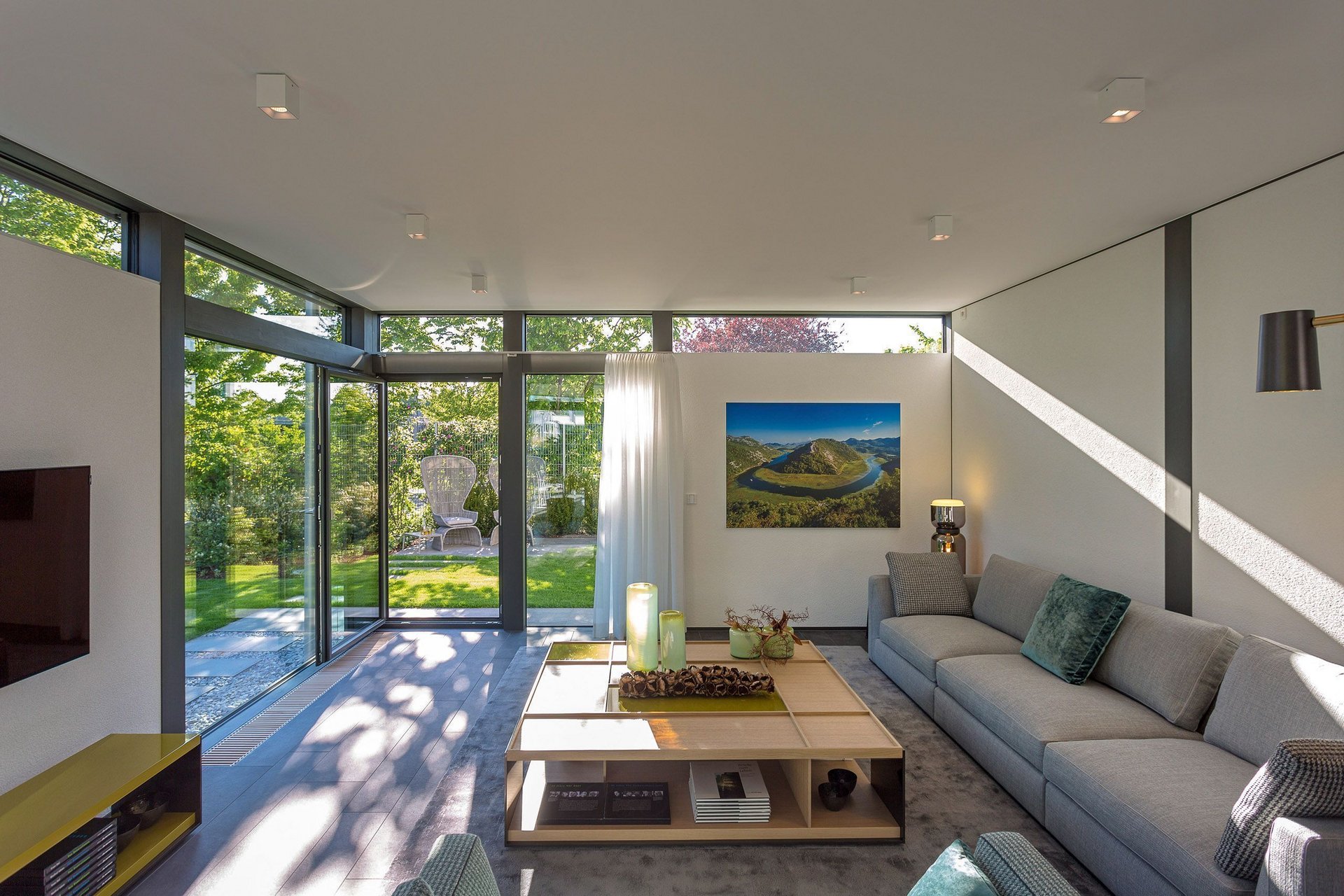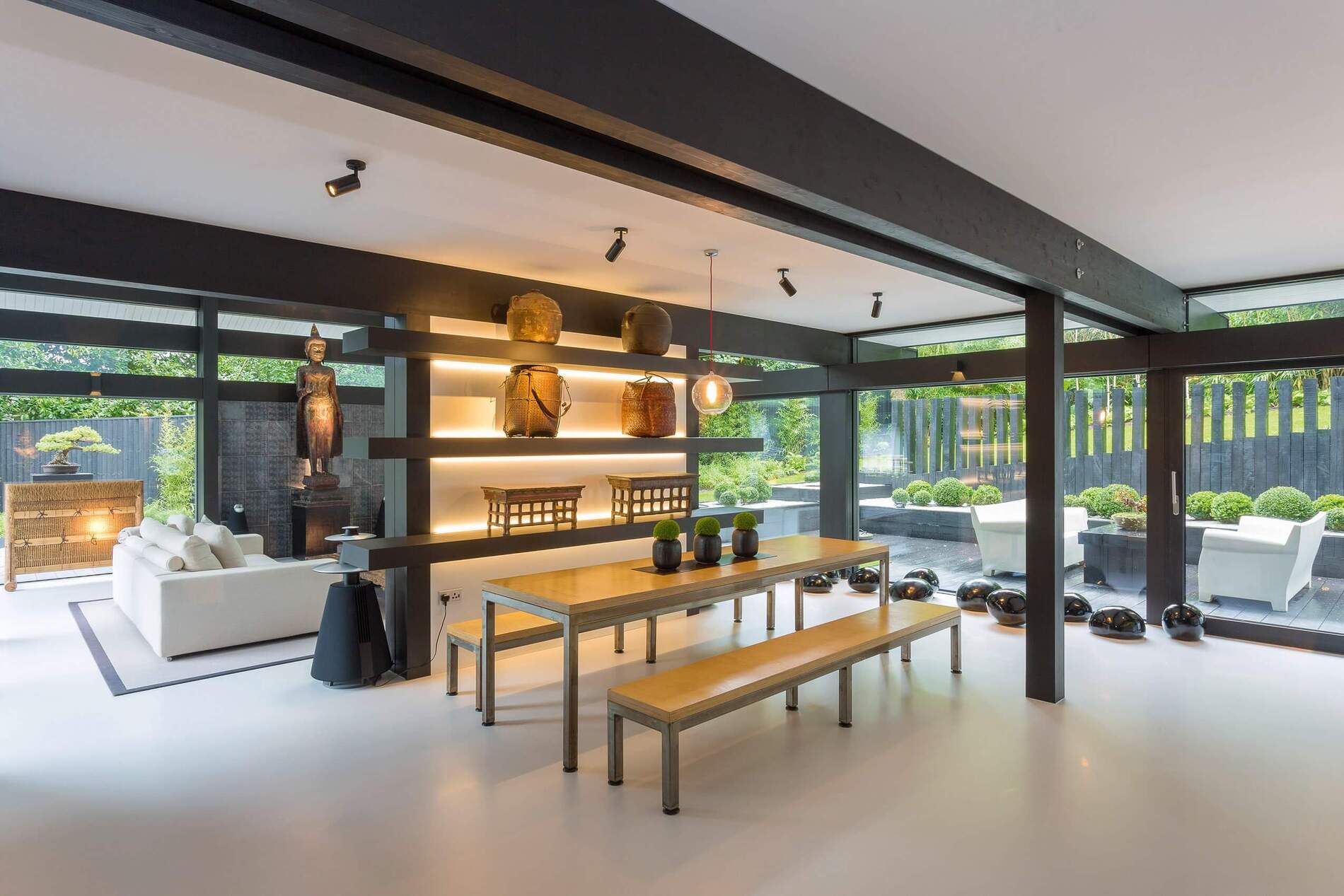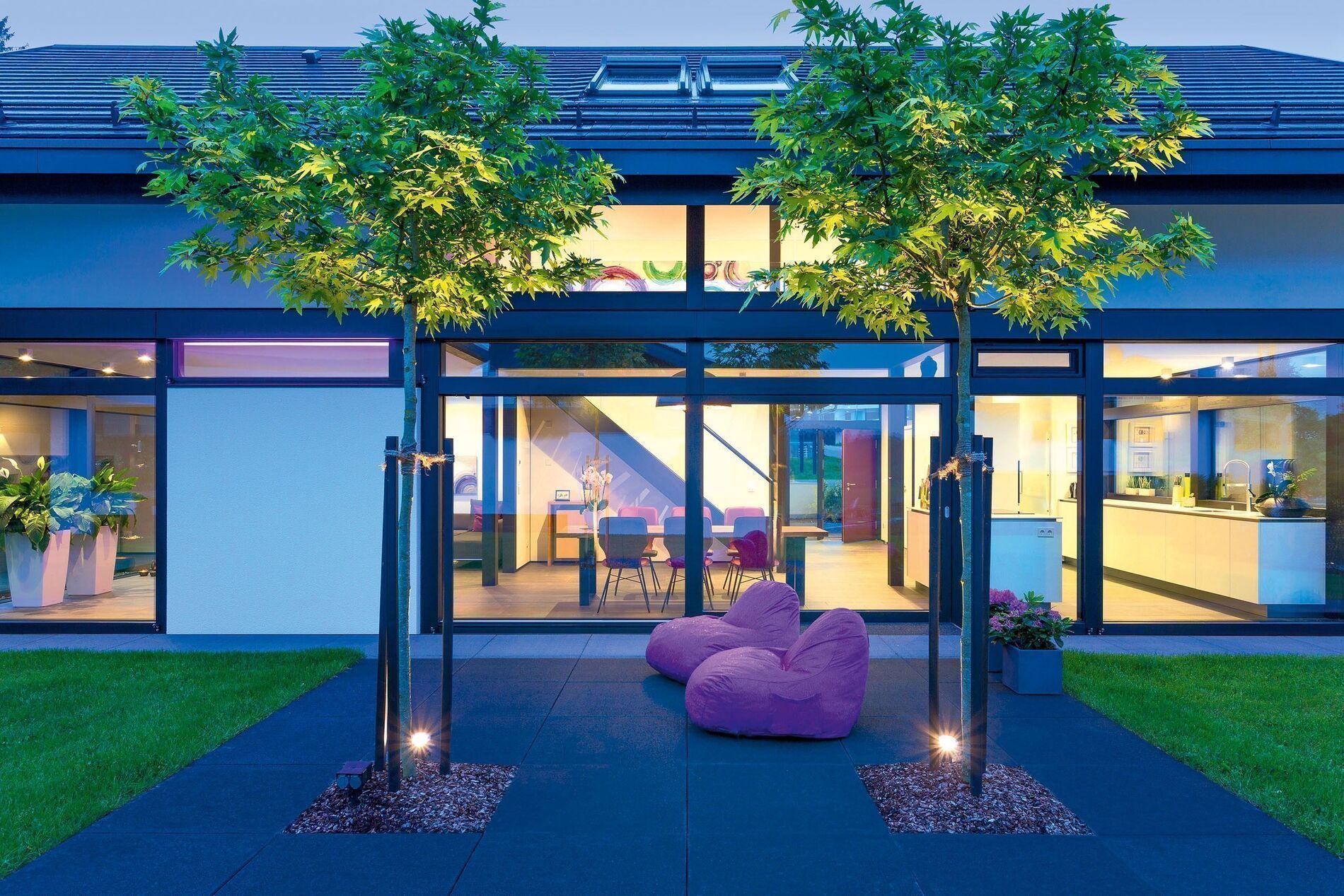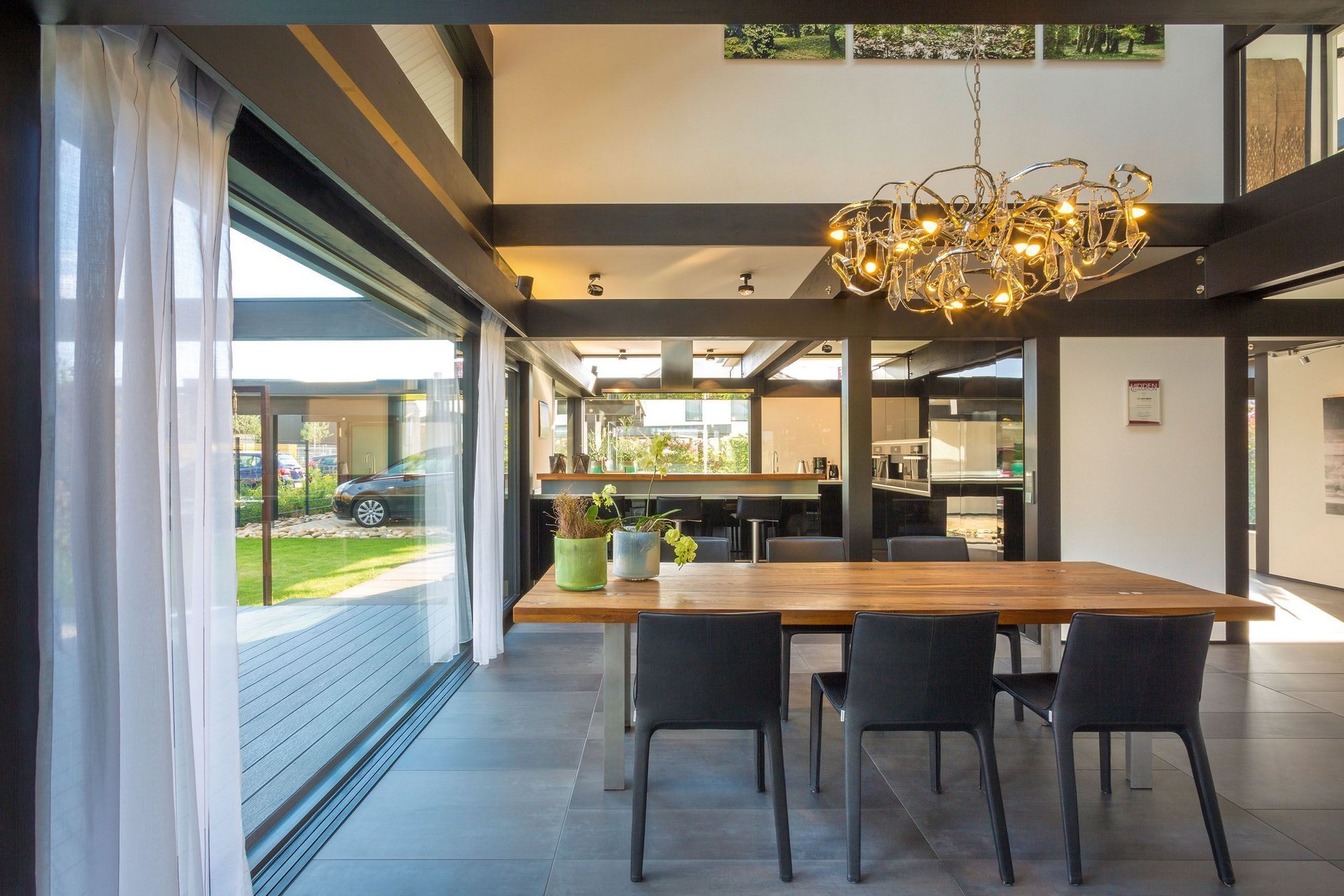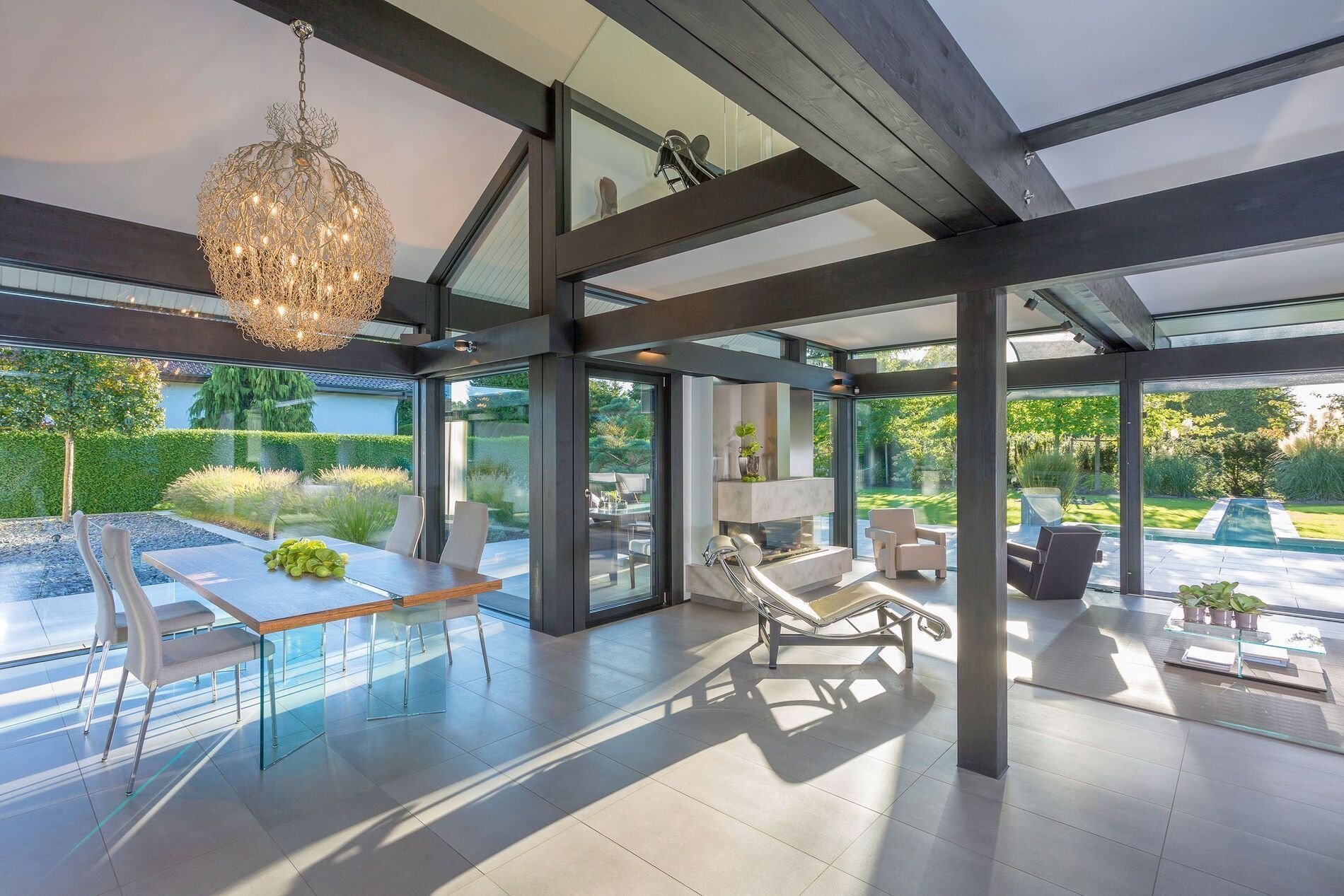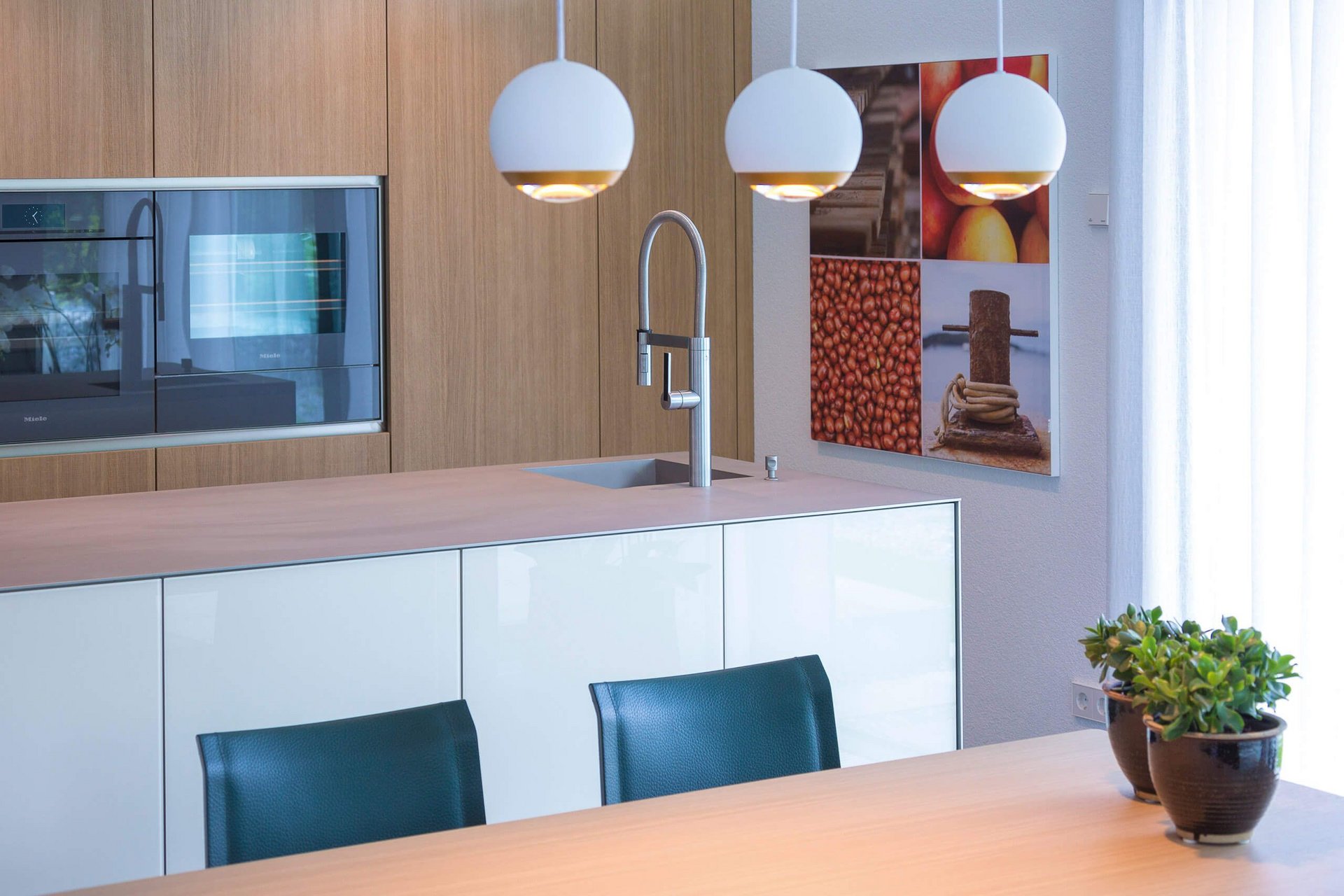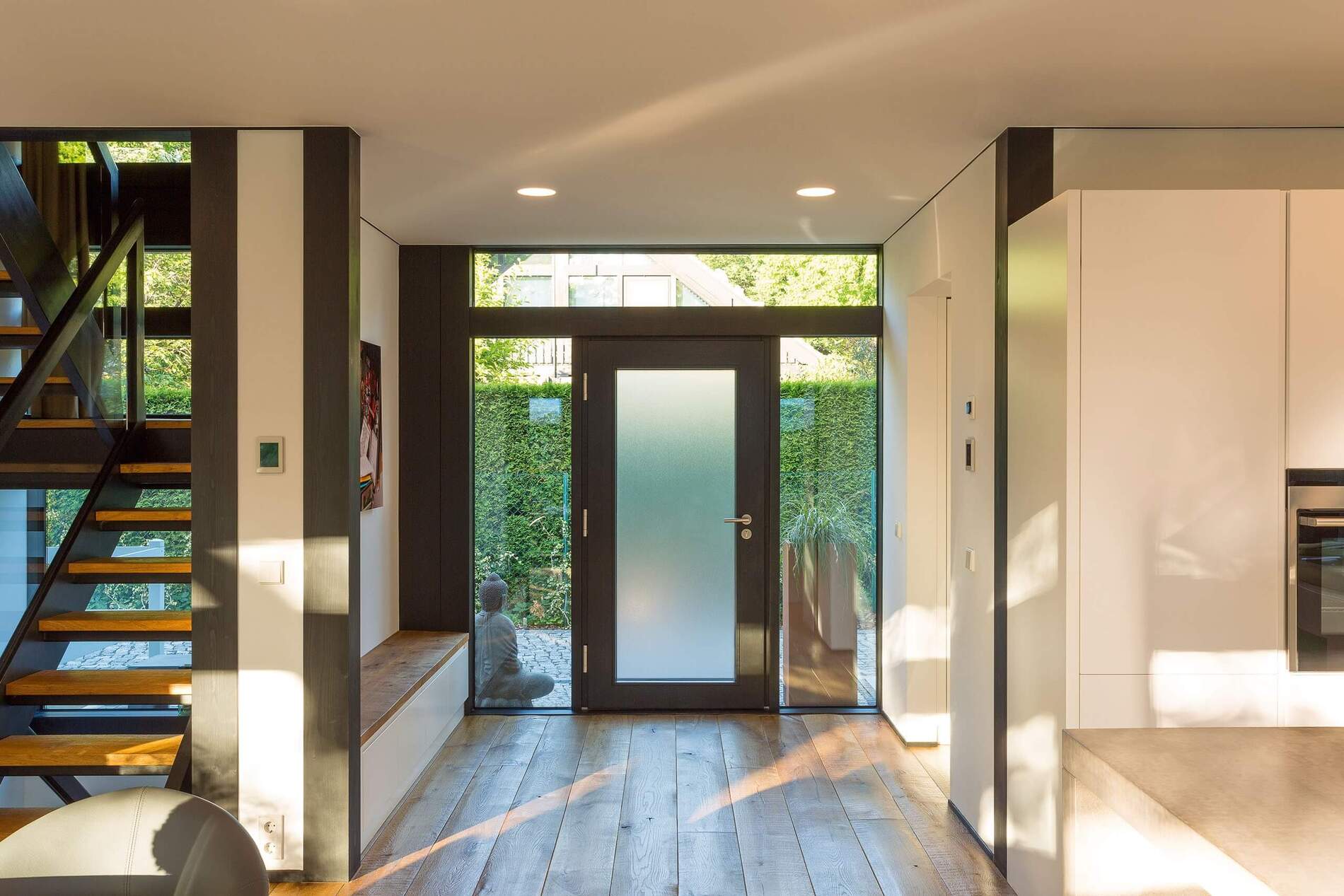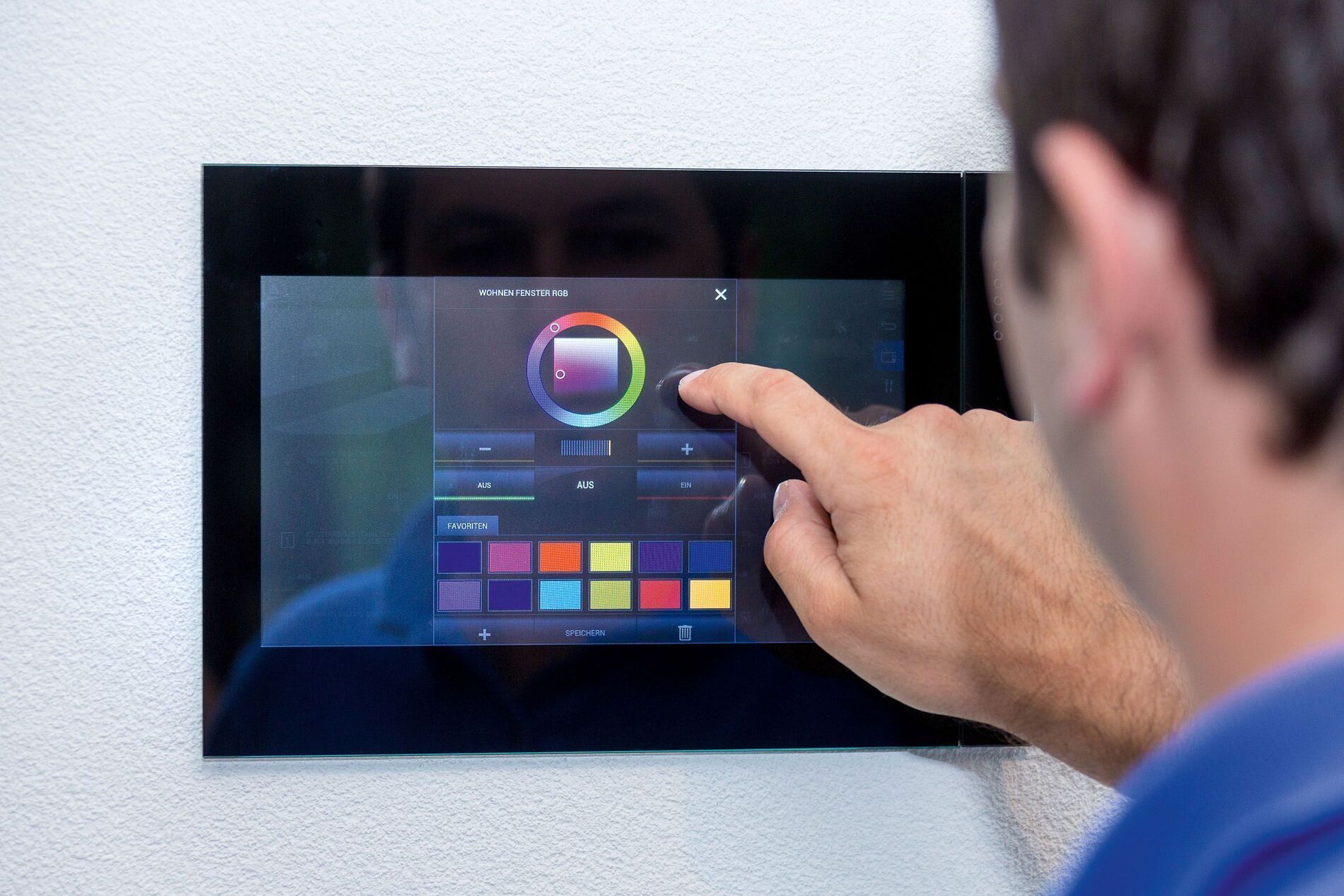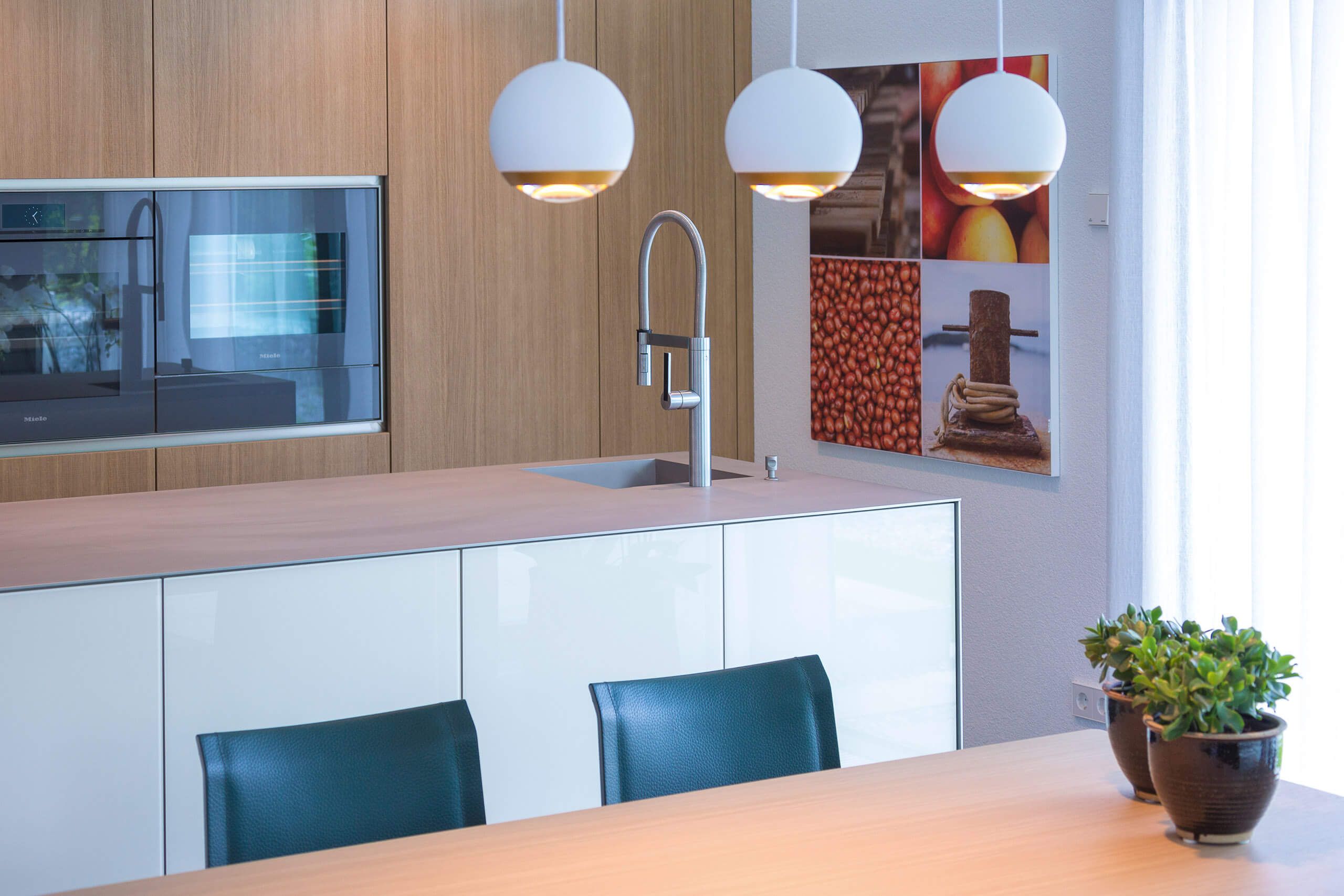
The system is calibrated every day anew by light impulses in the morning and the dawn of darkness in the evening. Without this natural process or through artificially generated deviations, the entire human organism gets confused.
Why is this the case? The colder blue daylight in the morning increases activity and performance through melanopsin, while the warmer reddish light and darkness in the evening ensure a good and healthy sleep through the release of the sleep hormone melatonin.
The fact that daylight also has a positive influence on mood and well-being in no longer a secret. Anyone who already has a home with large windows or glass fronts will appreciate the benefits of this natural miracle cure. Nevertheless, humans cannot do without additional light sources, because, especially in the autumn and winter months, we need illuminating aids in the early evening. The combination of transparent, nature-loving architectural style and expert lighting design is decisive for an optimal living experience.
Daylight – A piece of priceless quality if life
Since the early 70s, the HUF HAUS family business has been relying on a very special and transparent glass-timbered architecture, created by the architect Manfred Adams. Together with Franz Huf, he created, for the first time, fully-glazed gables and floor plans with flowing transitions and views of nature.
This connection with the natural outside world is still reflected today in the half-timbered houses interpreted in a modern way. The generous glass surfaces of the HUF houses are a visual highlight, providing plenty of healthy daylight and visually extending the living space into the garden. Office buildings in HUF style also bring light into everyday working life: Performance and motivation are the natural products of the bright rooms in generous wood-glass construction.
An unmistakable eye-catcher are the skylight glazings on the gable and eaves sides, which radiate an airy effect on the appearance of the house as a light band. HUF houses fascinate with their characteristic architecture and the “light art of nature”, which gives every room an individual appearance in every season and at every hour.
The HUF builders also appreciate this. “It is a priceless quality of life when the first rays of sunlight penetrate the gable windows and skylights early in the morning and fill the rooms with daylight,” the Fein/Lamp family expresses enthusiastically.
Stylish lighting concepts – as important as the furnishings
Light not only has a great influence on well-being, but also on the general feeling of space. When furnishing, this topic should, therefore, be given at least the same attention as the furniture and decoration. Because only with the right lighting can your favourite furniture, works of art or solitaire objects be perfectly staged.
The aesthetic and functional lighting design should be considered at an early stage of the planning process. Light can be used to create moods, create special living atmospheres, set visual highlights, structure rooms and emphasise architecture. A strong lighting concept makes all the difference!
Of course, there are general rules of thumb, but the lighting design is also very individual and must be adapted to the residents of the house and their needs. Those who also work from home need a well-lit workplace, often with bright, bluish light. In the bedroom, most people prefer warmer, indirect light sources.
As a consequence, this means that rooms used for different purposes also require different lighting concepts.
It gets exciting, for example, when a room has to accommodate several possible uses. A living room can be used for relaxing, reading or as a home office. For a healthy feel-good ambience, it must be possible to adapt the lighting to these different situations.
5 expert tips for your living room lighting
Brightness is not evenly bright and light is not evenly light. So that you can put together the right lighting concept for your own home, we have formulated five expert tips for harmonious and healthy living space lighting for you.
► Planning is the be-all and end-all
As with so much else, the same applies to lighting: Planning is half the battle. The earlier you start planning the lighting concept, the easier and more harmoniously it can be implemented. If you already plan the appropriate places for lights during construction, you will save tedious and unattractive cable laying. The concern for outdoor lighting is just as important as the sufficient number of sockets inside. The installation of motion detectors, for example in corridors or stairwells, should also be planned in advance.
► Focusing on needs
For the selection of the right luminaires, it is important to know the different uses of the rooms and not to decide purely according to aesthetic aspects. Cold light has a different effect than warm light.
In rooms such as the bedroom or living room, many people prefer warm light (below 3,300 Kelvin), while in the study or kitchen, they prefer cooler light (approx. 3,500 – 5,500 Kelvin). In principle, however, you should also take your personal feelings into account, some feel comfortable in warm light of around 3,000 Kelvin, others prefer cooler light of around 4,000 Kelvin. What some people find too bright is for others the ideal feel-good brightness.
In addition to the colour temperature, the colour rendering index must also be observed. This index indicates how real colours are represented in certain light. For dining tables, dressing tables and dressing rooms, you should therefore pay attention to luminaires with particularly good colour rendering quality.
► It’s the mixture that makes the difference
As a rule, there is not one perfect luminaire for every room – it’s the mixture that makes the difference. As a rule of thumb, you can remember that a mix of three different light sources produces the optimum lighting concept.
The basic light or room light is used for soft illumination of the entire room. Ceiling lights, ceiling floodlights or wall spotlights are ideally suited for this purpose. Zone lighting allows rooms to be structured and certain zones to be used to their advantage. Examples are the reading light on the sofa or the pendant light above the dining table. Mood lighting sets special accents and highlights, for example, through the targeted illumination of paintings and art objects.
Rüdiger Hau from Hau Lichtdesign makes connection somewhat more vivid and speaks of light for seeing (basic light), light for looking (zone light) and light for looking at (mood light).
The right mix creates an interesting and inspiring interplay of light and shadow. Even the weather can be simulated: cool indirect light on the ceiling combined with a warm wall spotlight imitates beautiful weather with blue skies and sunshine.
► On the spot
The correct positioning of the individual luminaires is also important for the right lighting concept, as this is the only way to achieve aesthetics, functionality and well-being at the same time.
The right position of mood lighting underlines art and architecture and creates highlights. Incorrectly positioned, however, luminaires can even attract unpleasant attention. For the luminaires above the dining table, a height is therefore recommended at which they neither impair nor dazzle the view of the person opposite. For ceiling spotlights in the kitchen, the distance from the wall should be chosen so that the entire work surface is pleasantly illuminated. Wall luminaires should be shielded or mounted at a height at which they cannot dazzle.
► In the eye of the behold
With the right mounting, even entire rooms can be optically changed. Many smaller light points on the ceiling make a room appear higher, while wall luminaires make rooms appear lower. If elongated luminaires are mounted transversely, they make narrow rooms appear wider. In this way, optical structures and boundaries can be created or changed for the eye of the beholder.
Energy efficiency obviously simple
Everyone is currently talking about climate change. Even within their own four walls, more and more people are trying to consider this issue and live as energy-efficiently as possible. The subject of lighting is a simple starting point for this.
The transparent architecture with floor-to-ceiling glazing already reduces the need for artificial light sources in HUF houses. But with the right light sources, electricity consumption can be minimised even further. LED is currently the magic word here.
LEDs are much more efficient than energy-saving lamps and even up to 13 times more efficient than the classic incandescent bulb. With the same amount of light, they save over 90 % of electricity costs. They are also available in a wide range of sizes, shapes and light colours and can therefore be used anywhere. If several models with different light colours are used, a wide variety of lighting scenes and moods can also be created.
In order to achieve really optimal energy-saving results, however, LED technology is also important: Quality instead of quantity. Jürgen Kaiser, Light designer at StilART, explains: “In any case, it is important to select quality products that combine longevity, high light quality and good design. This is part of our core competence in cooperation with our partner companies.”
In combination with motion detectors or smart home technology, energy efficiency can be driven to a maximum. Light sources are only switched on where they are really needed; if nobody is in the room, the light switches off automatically. If it gets brighter outside or focus on lights are switched on, for example in the reading corner or at the dining table, the other lights in the room are dimmed. Furthermore, certain lighting scenes can be pre-programmed so that only the light that is really required in the corresponding situation is switched on automatically.
Many HUF builders are therefore already equipping their new homes with expandable KNX technology for a smart home. Family S, also says: “In our former home, our evening ritual was to turn off the lights and – in the summer – perhaps open all the windows. Today, the Smart Home function of our house, in combination with the technology built into it, does everything by itself at the touch of a button.”
